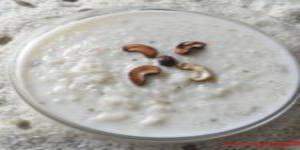
Scope
Payasam is like the Western pudding, a dessert, and is always the main sweet dish at Hindu temples and part of their celebrations. Payasam is derived from the Sanskrit work Payasa or Payasam, which means “milk”. The North Indian equivalent of the payasam is called Kheer. Other terms like Payasam or payesh (Bengal region) are also used.
Scope
The basic ingredients in a payasam include milk, rice, ghee and jaggery. It is garnished using dry fruits such as almonds, cashews, raisins, dry coconut (copra), etc. There is a popular version of North Indian kheer, prepared during festivals and havan in Varanasi which uses only milk, rice, ghee, sugar, cardamom, dried fruit, and kesar (saffron milk). It is an essential dish in many Hindu feasts, weddings, and celebrations.
While the dish is most often made with rice, it can also be made with other ingredients, such as vermicelli (semiya in South India, seviyan, sayviah, or other spellings) or tapioca (locally called sabudana). The Kashmir equivalent of payasam is firni which is made with semolina (suji), milk, saffron, sugar, dry fruits, etc.
In Gujarat, a variation of kheer known as d?dp?k, is made. The ingredients remain largely the same, but the cooking process is different and dudhpak is less dense and thick than kheer. The Odiya version, called kheeri is an integral part of the food served to the god at Jagannath Puri temple. The South Indian version, payasam (in Tamil, Malayalam, Telugu) or payasa (in Kannada), is an integral part of traditional South Indian meals and in festivals. South Indian payasam makes
extensive use of jaggery (vellam, bellam, bella, sharkkara) and coconut milk in place of sugar and milk. Vermicelli (semiya) is commonly used. The most common types of payasam in South India include milk payasam, sago/tapioca pearl payasam, Semiya (vermicelli) payasam, Paruppu payasam, Nei (clarified butter) payasam (also known as Aravana payasam), Carrot payasam, Wheat payasam, Wheat rava (wheat semolina)payasam, and Arisi Thengai (coconut and rice) payasam, Payasam is less thicker compared to kheer. In a South Indian meal, payasam or payasa, is served first at any formal or auspicious occasion.
Payasam is also served after rasam rice, while rice with buttermilk forms the last item of the meal. Payasam also forms an integral part of the Kerala feast (sadya), where it is served and relished from a flat banana leaf. In Kerala cuisine, there are several different kinds of payasam that can be prepared from a wide variety of fruits and starch bases. For e.g. chakkapradhaman made from jackfruit pulp and adapradhaman made from flat ground rice.
Karnataka payasa variants include the popular gasa-gase payasa made with poppy seeds, coconut (ground or grated), jaggery and a few almonds added at the end. Another one is the appey payasa which is poori (a deep fried flat bread made of wheat) with payasa. Akki payasa is made with rice, milk and jaggery, shavige payasa has vermicelli added to akki payasa or gasagase payasa. Hesaru payasa is made with green gram pulses or moong dal, jaggery and coconut milk. Godhi huggi is made with broken wheat, jaggery and coconut milk. Finally, the ell-neeru payasa is a coastal dish
made from tender coconut.
Payasa, Kheer/Kheeri etc. are also auspicious food fed to an infant during the annaprasanna ceremony, its birthdays or janmatithi, bhog prasad in the temples of Bihar, Bengal, Orissa.
The most basic payasam/kheer is the rice payasam.
Fundamental Concepts and Principles
Following ingredients are required for making Gooseberry Payasam :
- Rice husk ¼ padi
- Gooseberry 6 palam
- Milk ½ padi
- Brown sugar 7 and ½ palam
- Almonds 1 palam
- Cardamom powder ¼ palam
- Nutmeg powder 1/8 palam
- Mace powder 1/8 palam
- Raisins ½ palam
- Saffron veesam 1/16-rupee coin size
Method
- Pour 1 padi water in the vessel and boil rice husk in that water. After it boils, add gooseberry and soak it for half an hour. Remove the water and pour fresh water in it. Cut the gooseberries and remove the seeds from it. Boil the milk until it thickens. Put the gooseberries in it and after 2 minutes, add sugar. Stir it for 5 minutes.
- Soak almonds in hot water, remove the skin and cut them into slices. Grind the almonds with milk and pour this in the payasam. Add cardamom powder, nutmeg, mace and raisins. Clean the raisins and remove the stem. Wash it with water, dry it in a thin cloth, fry it in the ghee and add it to the payasam. You may also add saffron dissolved in milk.
Hindu Compliance Body
The Hindu compliance body was established under the executive order of The Supreme Pontiff of Hinduism, dated August 14, 2020, order number 10010, under the title Reviving the Hindu Compliance System and Body
to create, promote, spread and teach the standard procedures for all products and services that are in compliance Hindu Shastras.
Copyright
HCS has the copyright of all its publications. No part of these publications may be reproduced in any form without the prior permission in writing to HCS. This does not preclude the free use, in the course of implementing standard, of necessary details mentioned above. Enquiries related to copyrights to be addressed to KAILASA.
